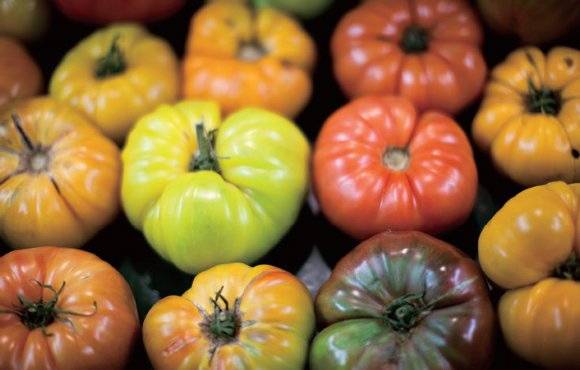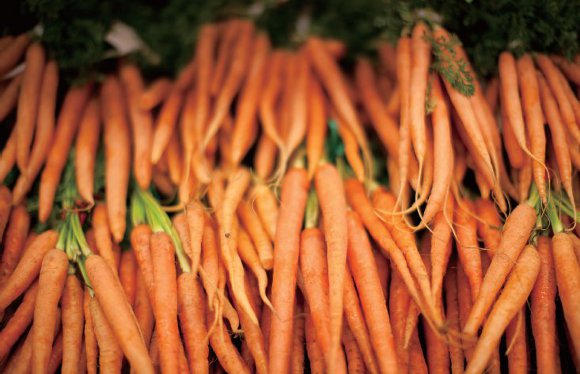Nine
Quick & Clean Food Shopping Strategies
Michael Pollan said it best in his book In Defense of Food: An Eater’s Manifesto: “Today there are thousands of other edible food-like substances in the supermarket.” Foods manufactured in factories make all sorts of alluring claims about how they’ve been “enhanced” to improve your health. Really? Think about that. Why would a manufactured food product be more beneficial than a natural, unadulterated whole food filled with vitamins, minerals, and other nutrients—not to mention flavor?
But all those “enhanced” and tempting foods can make a trip to the grocery store overwhelming and potentially dangerous to your health and your waistline. I’ve fallen for their allure and into the trap of shopping by those glossy circulars more than once, so here are a few tips based on my own hard-won experience to help you navigate the aisles.
Never go food shopping when you’re hungry: If you’re like me, going to the grocery store hungry is like committing diet suicide. Forget it! If you’re famished, it’s too hard to resist those things you would normally be able to talk yourself out of buying.
Never go without a list: You have to be ready to nip temptation in the bud, and to do that you need a plan. Without that list, the deli counter, the bakery, the prepared foods section, the snack center, and everything on sale will be sucking you in. But if you can walk into that store knowing exactly what you need to buy, you won’t start wandering aimlessly. Check out the store’s circular online so you know what’s on special before you get there. I do it all the time.
Avoid the interior aisles as much as possible: I know I’ve talked about this before, but it’s worth repeating. Sure, there are things you’ll need to buy in those aisles—just be wary. Stick with exactly what’s on your list.
Beware of the serving size: When you do buy something packaged, such as whole wheat pasta, brown rice, or sugar-free jam, make sure you read the label—especially the part at the top that says “serving size” and “servings per container.” A food can look relatively low in calories until you realize that the “calories per serving” are only for a quarter or less of the entire package.
Think about Going Organic
There are numerous arguments for going organic: It is better for the environment, produces safer and often tastier food, and is kinder to animals, to name just a few. But for now, let’s just focus on what it does for you.
Organic foods are grown (and in the case of animals, fed) without the pesticides used in conventional farming. Those pesticides have been shown to be toxic to humans, and the fewer of them you have in your system, the better off you will be, especially if you have any concerns about having children. Some pesticides found in conventionally grown foods have been shown to reduce fertility rates in women. Many of them have also been shown to be carcinogenic in large quantities. The problem is that we are exposed to so many chemicals—in the water, in the soil, and in the air—that we don’t really know how many are in our bodies. I think it’s best to avoid consuming them whenever possible.
That said, organic foods are generally more expensive (although you can now find them at many of the price clubs and big-box stores), so you may want to determine which foods to buy organic when you can. Personally, I start with milk and eggs. Most conventional milk is filled with antibiotics, artificial hormones, and pesticides, so if you or your children drink milk regularly, going organic would be a great place to begin. The same is true of eggs, because of the antibiotics fed to conventionally raised chickens.

As for the chickens themselves, if you can’t go organic, try for free-range. At least free-range chickens spend some of their time grazing and eating worms (what they’re supposed to eat). A study done by researchers at Pennsylvania State University found that eggs from grazing chickens have twice as much vitamin E, 40 percent more vitamin A, and three times as many omega-3s as conventionally grown eggs.
And of course, the same would hold true for organic, grass-fed cattle. When I eat beef, that’s what I buy.
When it comes to fruits and vegetables, the Environmental Working Group provides yearly lists of what they call the Dirty Dozen and the Clean Fifteen. The Dirty Dozen are those that are most likely to contain the most pesticides. They are (in order, starting with the worst):
THE DIRTY DOZEN
Peaches
Apples
Sweet bell peppers
Celery
Nectarines
Strawberries
Cherries
Kale
Lettuce
Imported grapes
Carrots
Pears
The Clean Fifteen are either those that have thicker skins (and are, therefore, less likely to absorb pesticides) or those we peel before eating. They are (starting with the best):

THE CLEAN FIFTEEN
Onions
Avocados
Sweet corn
Pineapples
Mangoes
Asparagus
Sweet peas
Kiwis
Cabbage
Eggplant
Papaya
Watermelon
Broccoli
Sweet potatoes
Tomatoes
If you’re deciding which produce to buy organic, start with the Dirty Dozen!
Go Local
Another way to eat well is to buy foods grown in your area. Why should you buy strawberries from California if you live in Michigan and there is a grower in your state? The strawberries closest to you will undoubtedly be fresher than those that have to travel hundreds of miles to your grocery store, and you will also be supporting your local farmers.
Buy Seasonal
If you buy foods when they are in season, you will find that they are generally more flavorful. And as they will be plentiful, they will also be less expensive. Historically, before refrigerated trucks and foods shipped by air, our ancestors ate both locally and seasonally. It’s fun and exciting to see fresh asparagus arrive in season, or to get really sweet corn and wonderful tomatoes at your local produce market or farm stand.
So far we’ve talked about a lot of different foods, some more expensive than others. But your new eating plan should never challenge your budget. There are many ways to eat well while also minding your money …
